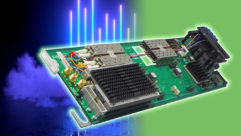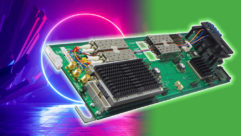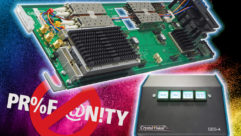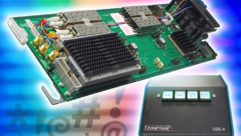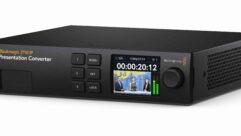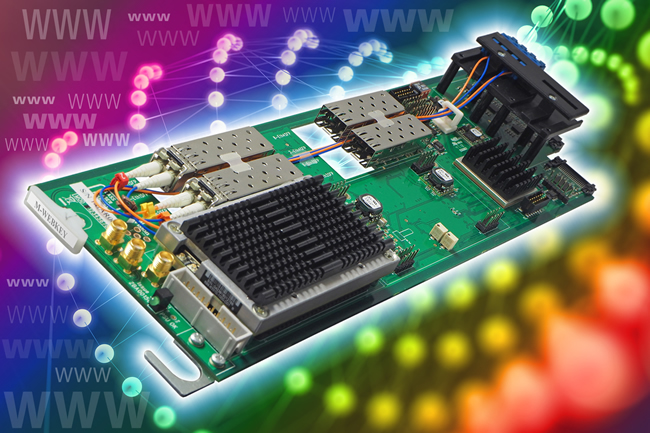
On Booth SL7409 at the 2020 NAB Show Crystal Vision will be showing the latest picture processing software apps for its MARBLE-V1 media processor hardware, all of which can work with IP, with SDI or with both IP and SDI at the same time. The functionality offered by these apps – which support ST 2022, ST 2110 video and 31 different SDI standards including 1080p – includes web browser keying, linear keying, picture-in-picture, clean switching, video delay, color correction and up and down conversion. Their support for multiple signal formats gives the easiest possible SDI to IP upgrade, while also making the apps perfect for mixed SDI and IP installations as well as fully IP environments. One of the booth highlights will be the unique M-WEBKEY IP/SDI web browser keyer app, which provides a cost-effective alternative to a full graphics system. Other SDI products on show include the popular Cleanit profanity delays and Safire 3 real-time chroma keyer.
Two of the new software apps being shown are keyers, ideal for channel branding as well as providing news, weather, advert and emergency information overlays for both IP and SDI infrastructures. All of Crystal Vision’s software apps run on the MARBLE-V1 media processor (a card housed in the Vision 3 frame) which features a powerful CPU/GPU processor, six bi-directional SDI connections and four 10GbE SFP+ network interface ports and allows different apps to be installed when needs change. The M-WEBKEY is an IP/SDI web browser keyer and is unique because it can key a web page on to a video input. The M-WEBKEY allows Flow 1 or a matte to be set as the background source, with the overlaid foreground source and key signal (which defines the graphic’s location and transparency) coming from the URL that is entered. With traditional keying, the external key and fill have to be created and output as video which requires expensive dedicated character generator hardware, whereas keying a web page means that the key and fill source never become video. The M-WEBKEY plus a web designer and web server could provide all the graphics for a channel – saving broadcasters money compared to a traditional graphics system. The M-WEBKEY can be used with IP, with SDI or with both IP and SDI at the same time for hybrid systems. Features include the ability to fade the key up and down, masks and cropping, a framestore synchronizer plus ten frames of video delay to help with system integration and extensive signal monitoring.
For those wanting a more traditional linear keyer which uses video sources for the background, key and fill, the new M-KEY software app is available – which can be used with IP, with SDI or with both IP and SDI at the same time. It allows Flows 1, 2 or 3 or a matte to be used as the background, and Flows 1, 2, or 3 to be used as the key signal and foreground overlay. Features include fades, masks, cropping and signal monitoring, along with a framestore synchronizer and up to ten frames of video delay to help sort out any timing issues.
Also being launched at the show is the M-PIP software app, an IP/SDI dual picture-in-picture device. The M-PIP has been designed for IP or SDI playout applications that need one or two picture-in-picture boxes to be inset on the main programme. It allows two input flows to be sized, positioned and cropped in advance (with edge softness and border generation available), and then layered – when required, using preset recall – over either the third input flow or an internal matte generator.
Crystal Vision’s clean routing switches have always been popular and the NAB Show sees the launch of a dual channel IP fail-safe routing switch that also works with SDI. Including two independent 2 x 1 switches, the M-SAFESWITCH-2 software app has been designed to guarantee a clean switch. With a full framestore synchronizer on each input (plus the ability to delay the earliest arriving input by up to ten frames), it can correct for any timing difference between the two inputs – resulting in no disruption to the output picture when a switch takes place. Further protection comes from the user-defined timing source priority for redundancy, with the option of selecting from the two analog references on the Vision 3 frame as well as PTP master and backup signals – should the main syncs become invalid, it will automatically switch to the specified backup syncs. Ideal for planned maintenance switches to manually re-route a good signal around broken equipment, the M-SAFESWITCH-2 can also be used as a very sophisticated auto changeover switch, with the option of selecting from ten different fault conditions to automatically trigger the switch. These fault conditions are input missing, input video standard incorrect, active video black, active video frozen, video error, packet loss, audio group 1 missing, audio group 2 missing, audio group 3 missing and audio group 4 missing.
Always well known for its video delays, Crystal Vision will be showing four new video delay software apps which work with IP, with SDI or with both and are designed for matching any system delays, such as those caused by virtual studio graphics, MPEG encoders and decoders, audio processing, HD radio links and satellite links. All include a framestore synchronizer and support PTP in addition to analog references as a timing source. The triple channel M-VIVID100-3 provides up to 100 frames of video delay per channel (two seconds in 3Gb/s and four seconds in HD and SD). The dual channel M-VIVID200-2 provides up to 200 frames of video delay per channel (four seconds in 3Gb/s and eight seconds in HD and SD). The dual channel M-VIVID400-2 offers up to 400 frames of video delay per channel (eight seconds in 3Gb/s and 16 seconds in HD and SD). Finally – for those big delay requirements – the single channel M-VIVID800 provides up to 800 frames of video delay (16 seconds in 3Gb/s and 32 seconds in HD and SD).
The M-COCO-2 is a dual channel IP/SDI color corrector and legalizer software app and has been designed for manipulating colors to correct for camera or lighting problems or to standardize pictures shot at different times. Its color correction tools include RGB gain, RGB lift, YUV gain, YUV lift, Video gain, Chroma gain, Chroma hue and both overall and individual RGB Gamma adjustment as well as – new for Crystal Vision – Black Stretch and Highlight Stretch, which are particularly useful for correcting in shot picture monitors.
Crystal Vision has always been known for the excellent picture quality of its up and down converters, and the tenth and final new software app being launched at the NAB Show is the M-UPDOWN-2 – a dual channel IP/SDI up and down converter. Perfect for any video-only application requiring format conversion in an IP infrastructure, it can also work with SDI or with both IP and SDI for hybrid installations. The M-UPDOWN-2 can up, down and cross convert between SD, 720p, 1080i, 1080psF and 1080p, with the 1080psF conversions offered by Crystal Vision for the first time. Each input flow has two independent outputs that can be different formats, perfect for studios and playout areas that need to operate in HD and SD simultaneously.
Some of Crystal Vision’s most popular SDI products in the US will also be available for demonstration on Booth SL7409. These include the Cleanit video and audio profanity delay system, which allows a live content stream to be delayed by up to 20 seconds (in HD), giving the operator time to react and prevent the broadcast of unwanted or offensive video or audio material. Also available for demonstration will be the Safire 3 real-time chroma keyer, with its simple intuitive workflow for setting up a key, support for resolutions from SD to 1080p and features such as lighting compensation, color correction and video delay.
Based at Whittlesford near Cambridge in the UK and with an office in the USA, Crystal Vision provides a full range of interface and keyers and helps people transition through a range of technologies – from SD to HD, from HD to IP and from IP to IP.


